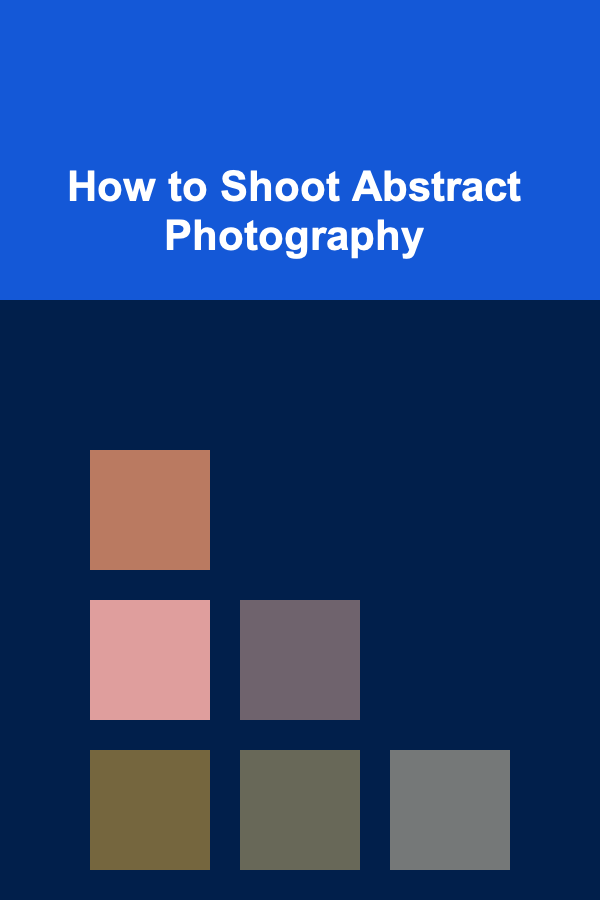
How to Shoot Abstract Photography
ebook include PDF & Audio bundle (Micro Guide)
$12.99$9.99
Limited Time Offer! Order within the next:

Abstract photography is a fascinating art form that allows photographers to express creativity beyond the conventional. Unlike traditional photography, which aims to capture recognizable subjects or scenes, abstract photography focuses on colors, shapes, lines, patterns, and textures, often blurring the line between reality and perception. This type of photography encourages a departure from the usual approach, where details and clarity are secondary to the emotional or visual impact.
In this comprehensive guide, we will delve into the techniques, mindsets, and approaches that can help you create compelling abstract photographs. Whether you're a beginner eager to explore this artistic medium or an experienced photographer looking for new challenges, this guide will help you take your abstract photography to the next level.
Understanding Abstract Photography
Before diving into the technical aspects, it's important to understand what abstract photography is and what it isn't.
What Is Abstract Photography?
Abstract photography is defined by its ability to capture visual representations that don't directly mimic reality. These images often break down the subject into fundamental elements, such as color, light, form, and texture, to evoke emotional responses or provoke thought. The viewer may not immediately recognize the subject or the context, and that's part of the beauty of abstract photography. It allows space for interpretation, inviting viewers to find their own meaning within the image.
What Abstract Photography Is Not
Unlike traditional photography, abstract photography doesn't focus on creating an accurate or realistic portrayal of a subject. It often avoids clarity, choosing instead to experiment with elements like light, shadows, movement, and perspective. Abstract photography is about making the invisible visible, using visual techniques that don't always follow the rules of conventional photography.
Key Elements in Abstract Photography
When creating abstract images, several elements play a pivotal role in the final outcome. Understanding how to manipulate these elements is crucial for crafting effective abstract photographs.
1. Color
Color is one of the most powerful tools in abstract photography. Vibrant, contrasting colors can evoke emotion, while soft tones and monochromes can create a calming or minimalist effect. Using color intentionally can significantly alter the mood and impact of an image. You can choose complementary colors for contrast or analogous colors for harmony. Experimenting with color in your photographs opens up a world of possibilities, helping you convey different emotions or stories without the need for recognizable subjects.
2. Shape and Form
In abstract photography, shapes and forms become the primary subjects of the image. Whether it's the curve of a leaf, the geometric patterns formed by light and shadow, or the chaotic streaks of motion, how you capture shapes can help convey an abstract aesthetic. Look for naturally occurring shapes in the environment or create forms through artificial means. Often, the beauty of abstract photography lies in simplifying the world around you into basic shapes.
3. Texture
Texture is another fundamental element that can bring depth and interest to abstract photography. Textures add tactile qualities to the image, inviting the viewer to experience the photograph with more than just their eyes. The roughness of a stone surface, the softness of fabric, or the fluidity of water can evoke different sensations, giving your abstract images an added layer of complexity.
4. Light and Shadow
Light plays a critical role in photography, but in abstract photography, light and shadow become even more important. The way light interacts with different surfaces can create interesting contrasts and patterns. Play with light sources, positioning, and reflection to craft abstract images that use light to create shapes, textures, and tonal variations. Shadows, too, can transform a mundane scene into an abstract work of art. The interplay between light and shadow can result in striking images that challenge the viewer's perception.
5. Motion
Incorporating motion into abstract photography allows for the creation of dynamic, fluid images. This can be achieved by using long exposures to blur motion or by photographing fast-moving objects with a specific technique to capture their streaks or patterns. Motion blur is particularly effective in abstract photography because it introduces a sense of change and fluidity, as well as the ability to transform ordinary scenes into unrecognizable, otherworldly compositions.
Techniques for Creating Abstract Photographs
1. Focus on Minimalism
Minimalism in abstract photography involves stripping away unnecessary elements to emphasize only the most essential components. Often, abstract images with minimal compositions are more striking because they focus the viewer's attention on one central element---whether it's a single color, a texture, or a shape. To create minimalist abstract images, you need to look for simplicity in your environment, such as isolated objects, repetitive patterns, or clean lines.
2. Use of Macro Photography
Macro photography is an excellent technique for abstract photography. By photographing small objects or details up close, you can create abstract images that transform the familiar into something unfamiliar. This technique reveals textures, shapes, and details that would otherwise go unnoticed, turning mundane subjects into compelling art.
3. Experiment with Multiple Exposures
Multiple exposures allow you to blend two or more images into a single photograph. This technique is particularly useful for creating surreal or dreamlike abstract images. It requires experimenting with different exposures, blending different textures, shapes, or colors to create a complex, layered composition. Using this technique, you can create ghostly images or layered effects that add depth and interest to your abstract photographs.
4. Intentional Camera Movement (ICM)
Intentional camera movement (ICM) is a technique where the photographer moves the camera during a long exposure. This movement can be subtle or dramatic, resulting in smooth, streaky patterns and blurred effects. ICM is an effective way to create abstract images because it allows for the abstraction of real-life scenes. By experimenting with different movements---up and down, side to side, or even circular---you can produce images that are entirely abstract, even if they start with a recognizable subject.
5. Playing with Reflections
Reflections can add a layer of abstraction to your photographs. Whether it's the reflection of a building in a puddle, the surface of a lake, or the reflection in a mirror, these surfaces can distort and change the appearance of objects, creating intriguing patterns and compositions. Look for reflective surfaces, and experiment with angles and perspectives to capture these reflections in new and abstract ways.
6. Experiment with Bokeh
Bokeh refers to the out-of-focus areas in a photograph, usually created by a shallow depth of field. These blurred spots of light can transform ordinary scenes into abstract compositions. By focusing on distant lights or creating your own light sources, you can create bokeh effects that are soft, colorful, and visually captivating. Experimenting with different shapes of light sources---such as star-shaped, circular, or hexagonal bokeh---can also result in unique abstract effects.
Tips for Success in Abstract Photography
1. Train Your Eyes to See Abstract Compositions
Abstract photography often requires a shift in perspective. Train your eyes to see beyond the obvious and look for interesting shapes, patterns, and textures in the world around you. Instead of focusing on the whole scene, zoom in on small elements, such as the curvature of a tree branch or the interplay of light and shadow on a surface. This practice will help you develop an eye for abstraction.
2. Experiment with Different Perspectives
Abstract photography thrives on unusual viewpoints. Try shooting from different angles, whether it's looking up, down, or sideways. Experimenting with new perspectives helps you see everyday subjects in a new light, revealing hidden beauty and abstract compositions you might not have noticed before.
3. Use Long Exposures for Time-Lapse Effects
Long exposures are a great way to introduce motion and create dreamy, abstract effects. By using a slow shutter speed, you can blur movement, such as clouds, water, or lights. This technique can create a sense of fluidity and depth, transforming familiar scenes into abstract, time-lapse-like visuals.
4. Shoot in Black and White
Shooting in black and white can simplify your compositions and help focus attention on the forms, textures, and patterns in the image. Without the distraction of color, the details of light and shadow become more pronounced, allowing for stronger abstract compositions. Black-and-white abstract images often have a timeless and emotional quality that can be deeply impactful.
5. Embrace Post-Processing
Post-processing can enhance the abstract qualities of your images. Editing software like Adobe Lightroom or Photoshop allows you to manipulate colors, contrast, sharpness, and other elements to further abstract your images. Don't be afraid to push the boundaries during the editing process---whether it's through color manipulation, adding textures, or distorting the image to create more surreal effects.
Conclusion
Abstract photography offers endless opportunities for creative expression. By focusing on the key elements of color, shape, texture, light, and motion, photographers can create captivating images that challenge the viewer's perception and evoke emotions without relying on recognizable subjects. Whether you're experimenting with long exposures, intentional camera movement, or minimalist compositions, abstract photography encourages exploration and experimentation. Remember, the beauty of abstract photography lies in its ability to transform the ordinary into the extraordinary, offering an invitation for both the photographer and the viewer to interpret the world in new and imaginative ways.

Building a Profitable Deep Learning Portfolio for Passive Income
Read More
How to Build a Stylish Storage Bench for Extra Seating and Storage
Read More
How to Design a Compact Yet Stylish Studio Apartment
Read More
How to Train Your Pet for Better Behavior and Bonding
Read More
The Database Administrator's Guide: Mastering Database Management and Optimization
Read More
How to Track Utilities Expenses Using Google Sheets
Read MoreOther Products

Building a Profitable Deep Learning Portfolio for Passive Income
Read More
How to Build a Stylish Storage Bench for Extra Seating and Storage
Read More
How to Design a Compact Yet Stylish Studio Apartment
Read More
How to Train Your Pet for Better Behavior and Bonding
Read More
The Database Administrator's Guide: Mastering Database Management and Optimization
Read More